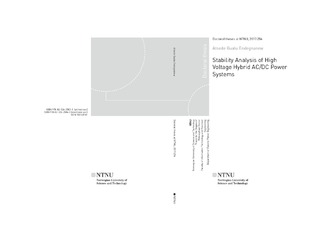| dc.description.abstract | Interest in large-scale integration of power from renewable energy sources (RES) has grown in the last decade as a result of energy policies adopted by governments in an effort to reduce CO2 and greenhouse gas emissions. Both large scale, and distributed solar and wind energy have proliferated the power system and will continue to do so in the future. Thus, large and complex transmission systems are needed for robust, flexible and secure operation of the future power system. Multi-terminal HVDC (MTDC) grids are expected to play an important role in an efficient socio-economic operation of the electric power system by acting as a means for integration of RES, exchange of balancing power, crossborder power market trading, grid reinforcement, etc.
As the introduction of MTDC grids will eventually result in a hybrid ac/dc power system, it is necessary to carry out a global analysis that considers the entire hybrid ac/dc power system, which includes both dc and all synchronous areas of the power systems. The main objective of this PhD is to study the stability of hybrid ac/dc power systems, with a particular focus on the ac grids. The work investigates how the dynamic characteristics of ac grids will be affected by the introduction of the MTDC grids and/or by control methods implemented in MTDC converter controllers.
Modal analysis, in particular eigenvalues, mode shapes, and participation factors, was used to identify and analyze interactions (dynamic coupling) between different subsystems in a hybrid ac/dc power system. Mode shapes were used to identify electromechanical interactions between generators located in different synchronous areas (asynchronous grids). The inter-grid electromechanical interactions are generally weak but are influenced by dc grid control strategy, controller tuning and damped frequency of electromechanical modes. The source of the interactions is dynamic coupling between ac and dc grids. When several terminals share the duty of dc voltage regulation, as in the case of dc voltage droop control operation mode, the dynamics of the ac grids behind those terminals are coupled to a common dc grid dynamics. This leads to indirect coupling of dynamics of different ac grids through dc grid dynamics. A qualitative analysis of state matrix of a single 2-level converter with and without connection to a detailed ac grid model was used to supplement the findings of the quantitative modal analysis. It was shown that there is a two-way dynamic coupling between ac and dc grids when a converter is operated in constant dc voltage or dc voltage droop control modes, i.e. ac grid dynamics is coupled with dc grid dynamics and dc grid dynamics is coupled with ac grid dynamics. However, there is only a one-way coupling between an ac grid and a dc grid if the converter is operated in constant power control mode. In such cases, the ac grid dynamics is coupled with the dc grid dynamics, but the dc grid dynamics is not coupled with the ac grid dynamics.
Decentralized control techniques were used to study interactions between power oscillation damping (POD) controllers on multiple terminals of an MTDC that interconnects several asynchronous ac grids. Interaction between the selected control loops was assessed using dynamic relative gain array and performance relative gain array techniques in the frequency domain. In addition, modal and time domain analyses carried out for the study case supported the findings from the frequency domain analysis. For the study case analyzed, it was found that due to control loop interactions the performance of one of the controllers was augmented, while the performance of the other controller deteriorated. The analyses clearly showed that control loop interaction should be considered while tuning PODs on converters even if they are connected to different grids.
Finally, a coordinated control strategy for terminal converters of a dc grid was proposed to address the issue of frequency disturbance in other ac grids when one grid receives frequency support from an offshore wind farm. It was shown that by coordinating converter controllers at the terminals of an offshore wind farm and one ac grid, it is possible to maximize frequency support contribution of the offshore wind farm and avoid disturbance in other ac grids connected to the MTDC. However, the proposed method works when only one ac grid is receiving frequency support and the remaining ac grids are connected MTDC terminals, which are operating in dc droop or constant power control mode. If more than one ac grids are to receive frequency support through MTDC grid, then negative interactions occur when the proposed controller is used. Therefore, in such cases, distributed dc voltage and frequency droop control is the best control option. However, it should be noted that with distributed dc voltage and frequency droop control method, the frequency support comes not only from the wind farm but also from other ac grids behind an MTDC terminal operating in dc voltage droop control mode. | nb_NO |
